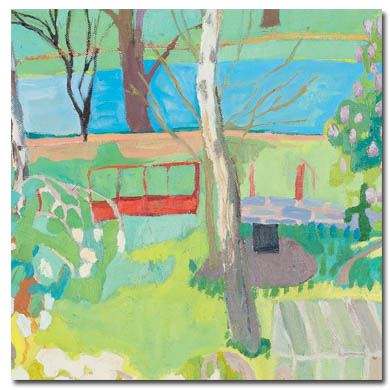
Hannah Brown, Never the same View, 2019
| Curator: | Linda K. Sedláková |
|---|---|
| Venue: | Galerie Gema, Máchova 27, Praha 2 |
| Dates: | 11. 10. - 29. 11. 2019 |
| Contact: | www.galeriegema.cz |

| Curator: | Linda K. Sedláková |
|---|---|
| Venue: | Galerie Gema, Máchova 27, Praha 2 |
| Dates: | 11. 10. - 29. 11. 2019 |
| Contact: | www.galeriegema.cz |
Hannah Brown (1993, Portland, OR)
Despite being an American and born in the United States, Hannah lives and works in Lázně Toušeň. Her father works as a pastor in the Church of the Brethren in nearby Čelákovice. She first began to study fine arts at the Classical School of Folk Art in Toušeň, but later obtained her higher education in the field at Biola University in California (USA), where she completed an internship with prof. Barry Krammes (artist dealing mainly with assemblages). In addition, she worked as a technician in a university ceramics workshop. In addition to paintings, drawings, sculptures and various installations, Hannah also enjoys piano improvisations (she has also attended piano lessons since childhood). She currently occasionally conducts art courses, such as an open-air workshop for adults or an art course for children and young people.Hannah also collaborates with a number of institutions and also conducts music at the Church of the Brethren in Čelákovice. Her work is based on observing the surroundings, specifically the Elbe landscape, which is mostly her home. As a person who lives with one foot in the USA and the other in the Czech Republic, the painting helps her anchor the "consciousness of home", however echoes of other places that are part of it may be heard in the Elbe countries. These include mainly California, where she studied and has siblings, Oregon, where she was born and has grandparents, and Georgia, where she has second grandparents. The collection of exhibited paintings interprets changes in the landscape, with repeated records of the same place, which always change - whether due to external or internal circumstances (changes in the author's moods, changes in light during the day and individual seasons, etc.). The paintings also show a certain melodic rhythm, given the author's strong musical sensibility. Her works also serve as a kind of musical notation for her piano improvisations. The connection between painting and music is therefore very strong, perhaps unknowingly it follows Kupka's orphism, which is approached by the strokes of her brush…